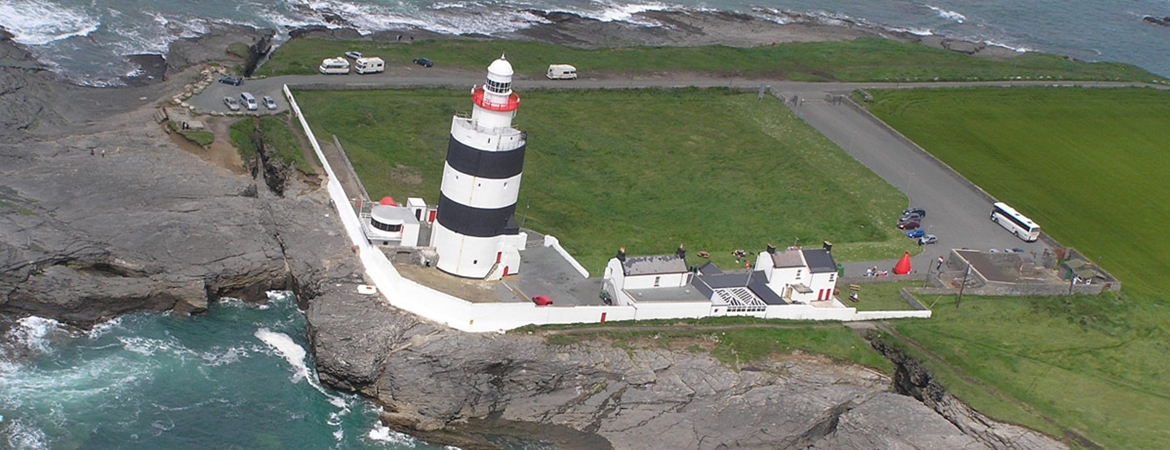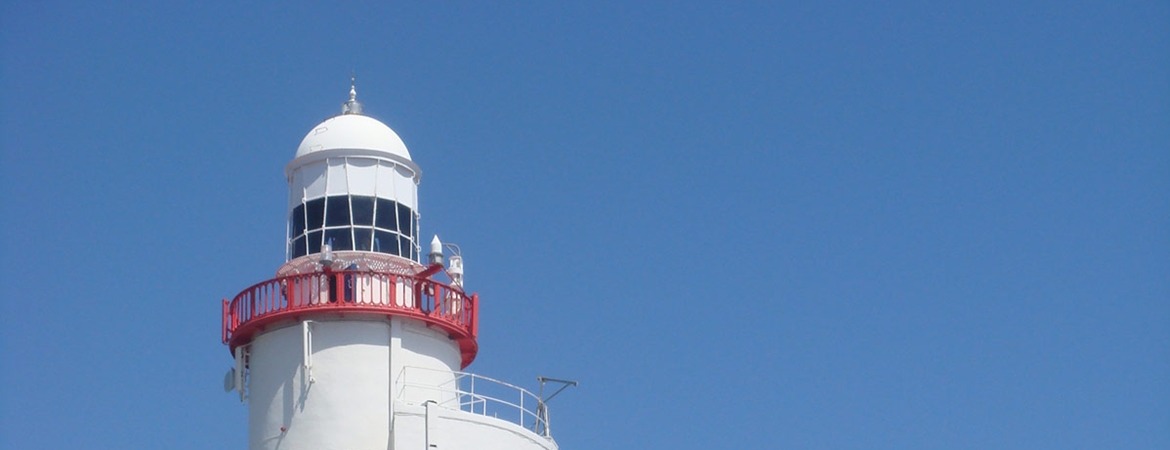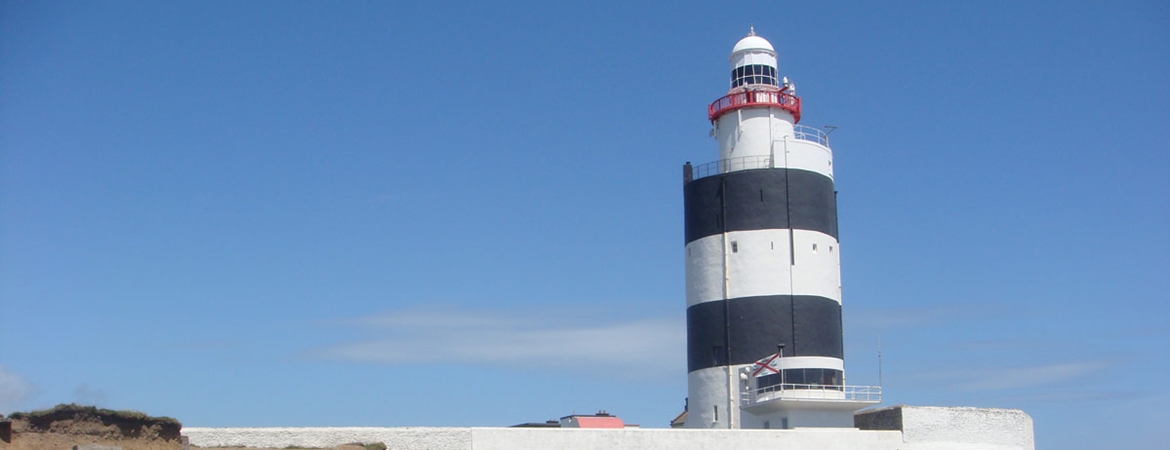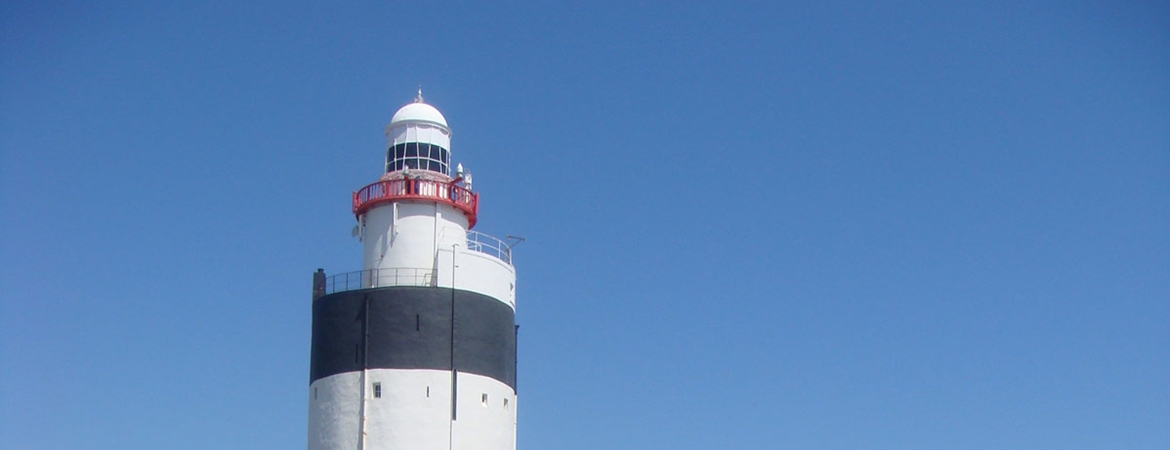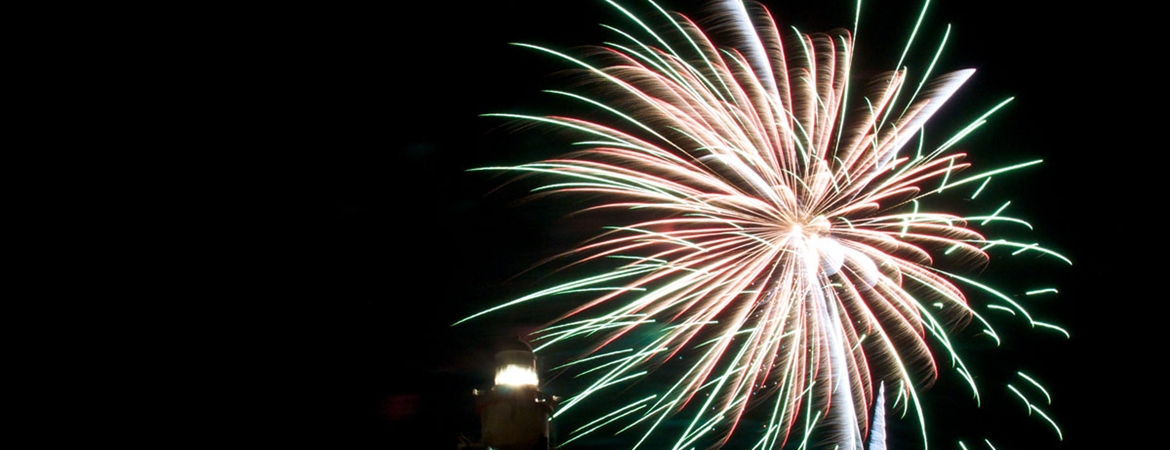 |
Hook Head Lighthouse is one of 70 lighthouses operated by the Commissioners of Irish Lights around the coast of Ireland and plays a vital role in maritime safety. It is also one of twelve lighthouses which make up Great Lighthouses of Ireland, a new all-island tourism initiative. Visitors from home and abroad now have the chance to visit or stay in a lighthouse and to find out about our history and heritage, to appreciate the spectacular natural world around us, to discover the technology at work today and to engage with our coastal communities. With aspects to appeal to people of all ages and interests, Great Lighthouses of Ireland offers memorable and enriching experiences and creates appreciation of the role of lighthouses past, present and into the future. To find out more about Great Lighthouses of Ireland click here |
History
In the 5th century a Welsh monk named Dubhán, seeking to lead a life of solitude, founded a monastery on the site where the old church of Churchtown now stands, 1.6 km north of Hook Head overlooking the entrance into Waterford Harbour. The promontory became known as Rinn Dubhán or Point of Dubhan. By coincidence, the word dubhán or duáin in the Irish language means fishing hook. Following the Anglo-Norman invasion, Dubhán was translated to Hook or Point of Hook. Later it was also known as Hook Head and sometimes just The Hook.
According to tradition, Saint Dubhán established a beacon on Hook Point which is almost certain to have been a chauffer on top of a mound or pile of stones burning either timber or other local combustible fuels-a valuable navigational light for vessels entering the natural haven of Waterford Harbour.
Between 1170 and 1182 a Norman from Pembrokeshire, Raymond LeGros, husband of Strongbow's only sister, landed at Baginbun, a small promontory on which were the remains of a Celtic fort, Dundonnell circa 100 to 200 BC 9km north east of the Point of Hook. Here, LeGros set up another fort and subsequently crushed the Norse and Irish advance from Waterford, regarded by some as a turning point in Irish history. "At the creek of Baginbun, Ireland was lost and won."
LeGros was killed in 1182 but, according to some authorities, had left his mark by building the first Tower of Hook, c.1172, to replace the original beacon and which also acted as a castle to guard the entrance into the harbour. However, more recent authorities attribute Hook Tower to William Marshal, Earl of Pembroke, in 1245. The tower, and the beacon on its top, was vested in the custody of the monks who were by then affiliated to the Priory of Saint Augustine in Ross and whose own monastery had been renamed Saint Saviour's of Rendevan.
Monks continued to tend the beacon even through Henry VIII's suppressions. Over the years the land on which the tower was built changed hands many times. At the outbreak of civil war in 1641 the monks left Churchtown and their lightkeeping duties ceased. Cromwell did nothing to maintain the beacon and shipwrecks became commonplace. Mariners engaged the Governor of Duncannon Fort, Colonel Cymon Rudgeley, to petition the Revenue Commissioners in 1657 to re-establish the Hook beacon. This petition was unsuccessful and mariners had to wait until Charles II granted Letters Patent to Sir Richard Reading in 1665 to erect six lighthouses around the coast of Ireland, one of which was at Hook. By 1667, or soon after, the six lighthouses had been built and Hook re-established.
Hook Tower was originally 18m high and approximately 8.5m in diameter. It was subsequently enlarged to 24m high and to approximately 12m in diameter (it is not truly circular) with a spiral stone stairway sandwiched between the outside of the old wall and the inside of the newer wall. When the tower was enlarged has not been established; definitely not in Reading's time, but he may have been responsible for the construction of a lantern to house the beacon fire on top of the tower. This was not uncommon practice in those days. It shielded the fire from gusty winds and, with a flue through the roof or dome, conducted the smoke clear of the fire thus exhibiting a better and brighter light for the mariner. In their book Lighthouses, Rosemary Christie and Douglas Hague quote an estimate for the alteration and repair of the lantern at Hook Lighthouse from a 1704 report on the state of Irish lighthouses. Whilst this does not categorically state there was a lantern, it mentions among other things, items such as - "lyme for pointing and recasting the outside of the tower and other mason's work about the lanthorn and battlements, also 140 foot of glass for the lanthorn, iron for the grate, bricks for the breast of the lanthorn."
During 1704 Queen Anne transferred the lighthouses around the Irish coast to the Revenue Commissioners. Hook was not immediately taken over because one Henry Loftus, of nearby Loftus Hall, held the tower under a twenty-one year lease. It passed to his son Nicholas, who then engaged the Revenue Commissioners in a dispute regarding the renewal of the lease. In 1726 he threatened to extinguish the light unless a rent of £200 was advanced by the Commissioners. The dispute went on for two years. Fortunately the light was not extinguished and the outcome of the lease was that it was renewed for a rent of £120.
The tower fell into disrepair as can be seen from a contemporary engraving dated 1792, but in 1791 the Revenue Board granted Thomas Rogers a contract to maintain and staff Hook Point along with other lighthouses, namely Howth, Cranfield Point, Kilwarlin (South Rock), Copeland, Aranmore, Loophead, Old Head (Kinsale), Charlesfort (Kinsale) and Duncannon Fort.
At Hook Rogers erected a new 3.65 m diameter lantern and installed twelve Argand oil lamps with reflectors. This was confirmed in Rogers's report to the Board of the Corporation for Preserving and Improving the Port of Dublin (the Ballast Board) in August 1810, but the following month the Ballast Board's own inspecting committee, Messrs Halpin, Baker and Bigger reported that Hook had thirteen lamps and the lantern was fitted with ten lenses (panes of what today we call bottle glass) and three sheets of plate glass.
The apparatus was improved in 1812 and again in 1864 when a new lantern and fixed dioptric lens replaced Rogers's lantern and the 1812 catoptric apparatus. During the replacement of the 1791 lantern cinders from the coal burning grate were found on top of the tower. J. S. Sloan, Clerk of Works in 1864, describes in his book Manual for Lightkeepers (1873) Reading's turret of 1665 - 67 as being, "9m high and 6m in diameter with an external staircase to about half its height which continued to the top inside the thick wall." The turret had a strong vaulted roof to carry the coal fire. This was removed to Sloan's redesigning together with 3.2m of the wall. A cast iron lantern floor was set on top of the wall and the present lantern was then added.
Coal gas replaced oil lamps in 1871 and lasted until 1910. On New Year's Day 1911, a revolving third order 500mm focal distance optic replaced the dioptric lens, and vaporised paraffin took over from coal gas as the source of light; paraffin succumbed to electricity in 1972 when the intensity was increased to 480,000 candelas. The duration of the flash was decreased to 0.11 seconds, the character being Fl W 3 secs. The range of the light was 25 nautical miles.
Another aid to navigation, a fog signal bell, was introduced in 1838. This in turn was replaced by a gun in 1872 and in 1905 by an explosive charge on the end of a jib attached to the dome of the lantern with a character of two shots every six minutes. This was changed to one shot every 5 minutes in June 1937 with a brilliant flash accompanying the fog signal when sounded by night. This flash was discontinued during World War Two and re-introduced in 1949. With the tightening of security in the early 1970s the explosive fog signal was discontinued and in 1975 was replaced by a compressed air operated supertyfon emitter which gave one blast every 30 seconds. In 1995 this pneumatic fog signal was replaced by an electric horn with a character of 2 blasts every 45 seconds. Since 1978 the light is exhibited in poor visibility whilst the fog signal is sounding. On 11th January 2011 the fog signal at Hook Head was permanently discontinued. The light continues to be exhibited in reduced visibility during daylight hours.
In 1933 the colour of the tower was altered from white with three red bands to white with two black bands.
A Racon (radar beacon) was established in November 1974.
Lightkeepers families were withdrawn in 1977 and Hook Lighthouse became relieving like its offshore counterparts. Six Keepers, two Principal and four Assistant Keepers were attached to the station, three being on duty at any one time. The Keepers' tour of duty was four weeks on and four weeks off.
The station was converted to unwatched and the Keepers were permanently withdrawn on 29 March 1996. The Aids to Navigation and equipment are controlled and monitored through a telemetry link with Dun Laoghaire. Monitoring equipment for Coningbeg Lightfloat is also installed at the station and all information is automatically relayed to the Central Control at Dun Laoghaire.
In January 2009 AIS (Automatic Identification System) functionality was added to Hook Head Lighthouse.
While remaining a fully operational lighthouse in the care of an Attendant, Hook Head now also accommodates a heritage centre with tours of the lighthouse. Information of this visitor attraction can be obtained on Hook Heritage Ltd website at www.hookheritage.ie/.


